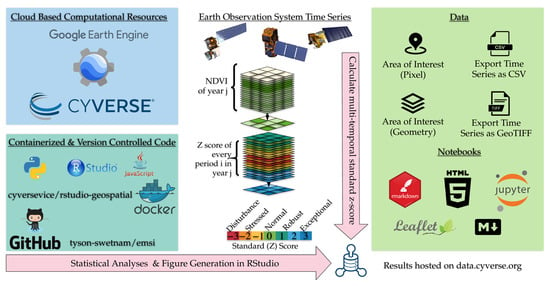On the Use of Standardized Multi-Temporal Indices for Monitoring Disturbance and Ecosystem Moisture Stress across Multiple Earth Observation Systems in the Google Earth Engine
Abstract
1. Introduction
1.1. Justification
1.2. Fuel Moisture Stress Index & Standard Vegetation Index
1.3. An Open Science Approach
2. Materials and Methods
2.1. Earth System Observations
2.2. Normalized Difference Vegetation Index (NDVI)
2.3. Calculating EMSI from NDVI Time Series
2.4. Computations in the GEE CyberGIS versus Local Computing
2.5. Study Areas
3. Results
3.1. EMSI Spatial Variablity over Time
3.2. Seasonal Flooding of an Inland Delta Lowland versus Localized Drought in a Thornscrub Upland. Botswana, Africa
3.3. Grazing Pressure in a Semi-Arid Grassland, Arizona, USA and Sonora, Mexico
3.4. Drought in Rainforests and Rapid Agricultural Expansion in a Tropical Rainforest, Acre, Brazil
3.5. Winter and Repeated Wildfires in a Taiga Forest, Yakutia, Russian Federation
4. Discussion
4.1. Establishing the Appropriate Reference Period
4.2. Ecosystem Phenology and Disturbance Detection
4.3. Utility of a Multitemporal Standardized Index
4.4. Limitations
5. Conclusions
Author Contributions
Funding
Institutional Review Board Statement
Informed Consent Statement
Data Availability Statement
Acknowledgments
Conflicts of Interest
Appendix A
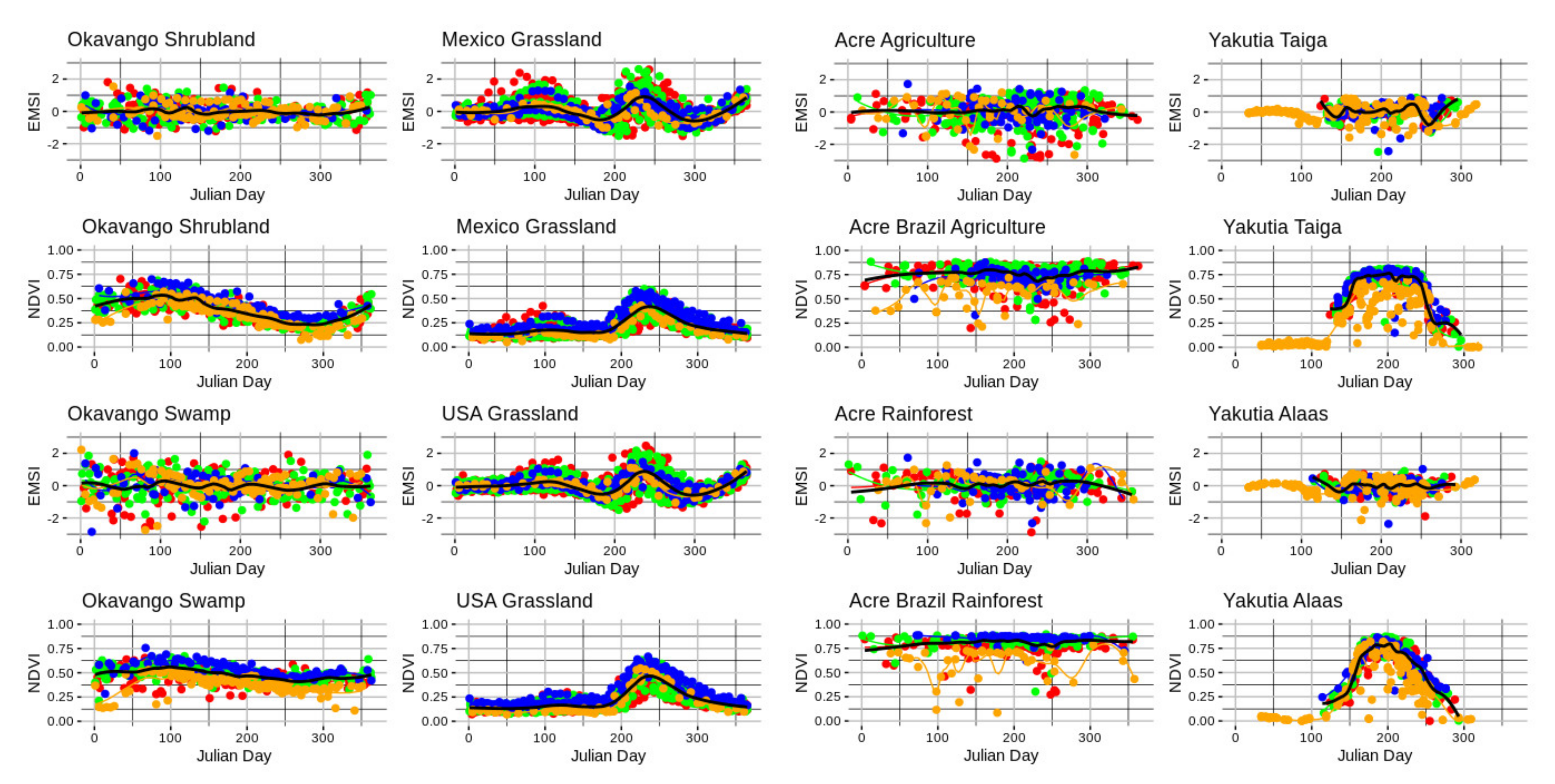
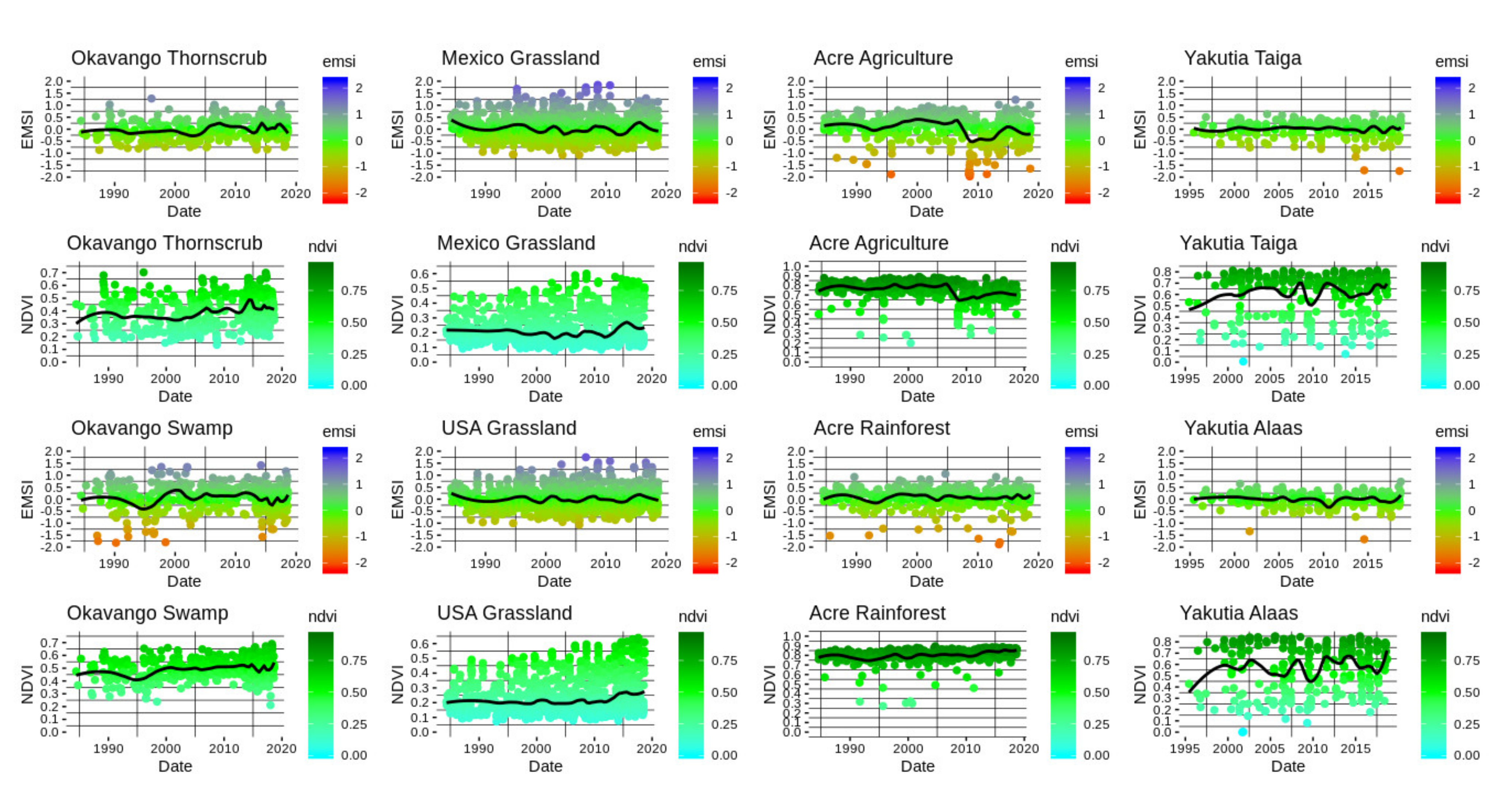
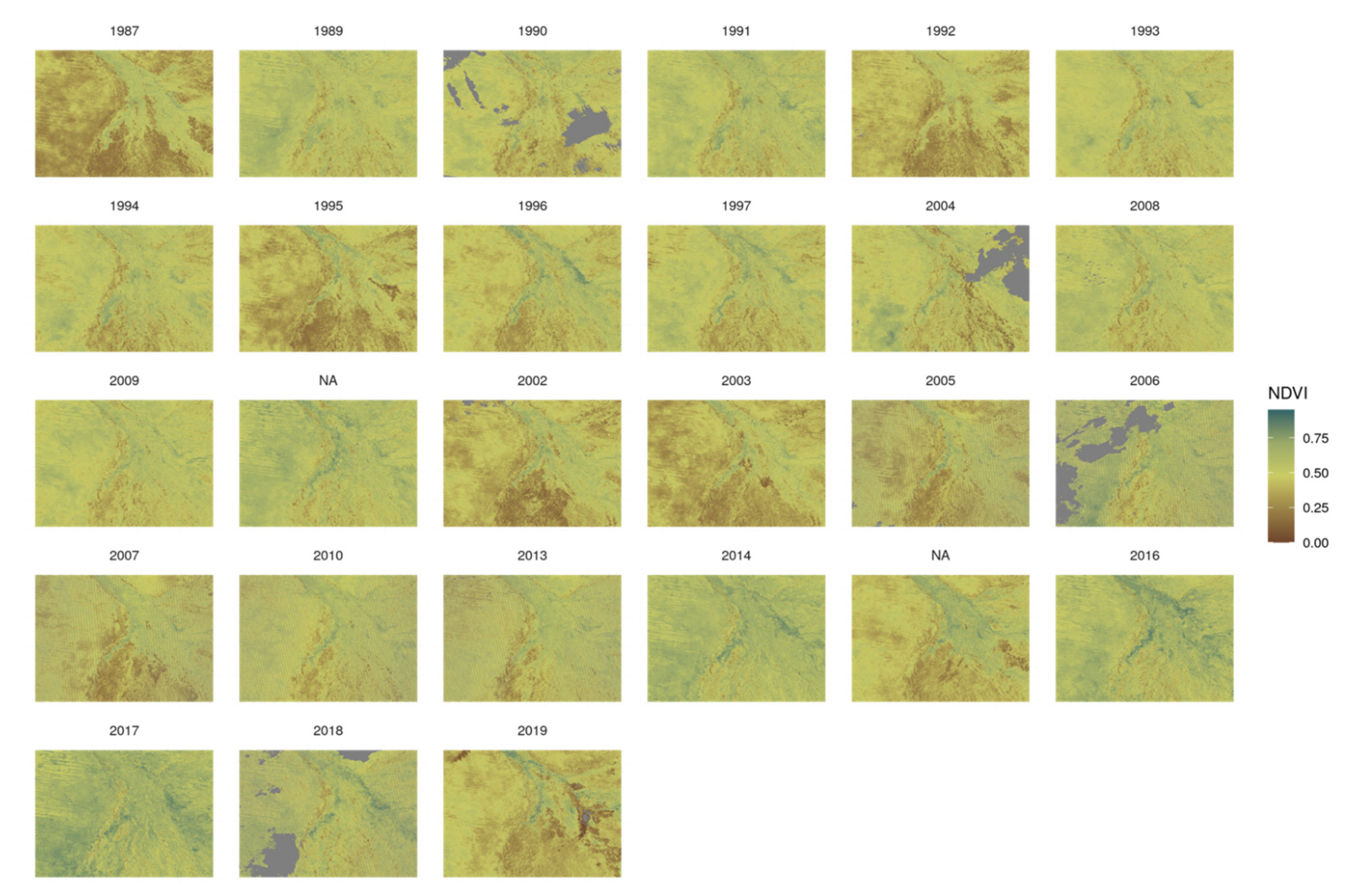
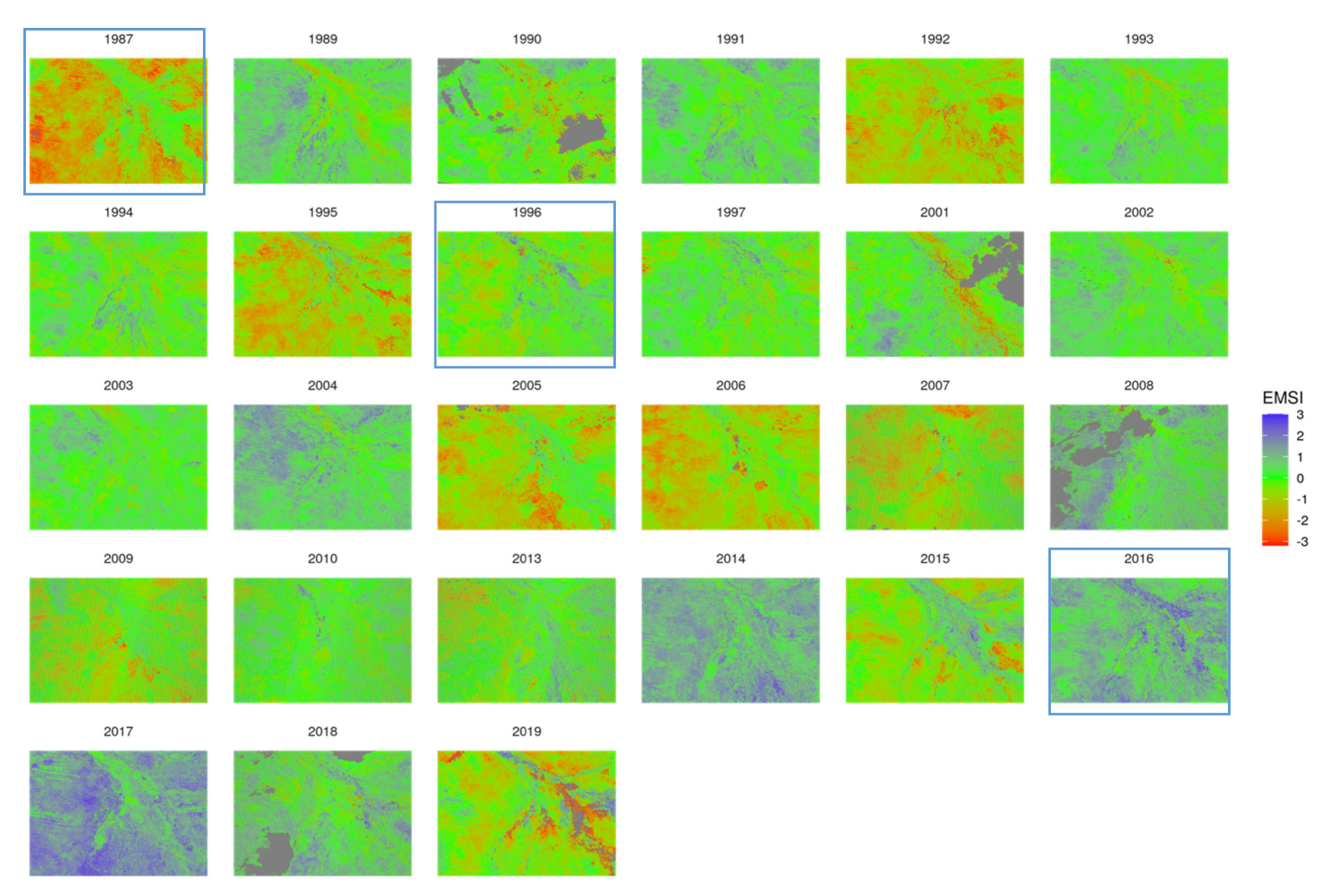
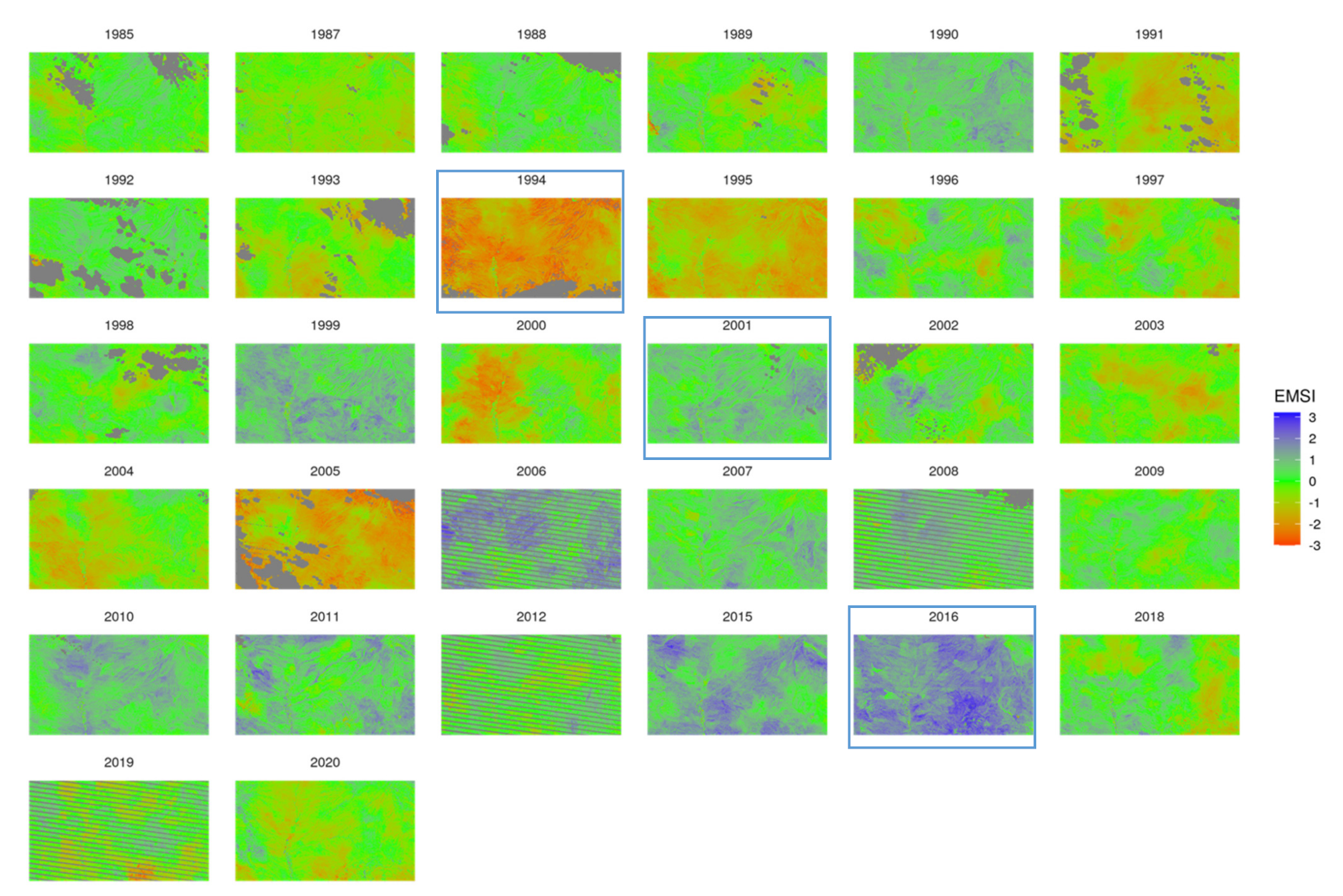
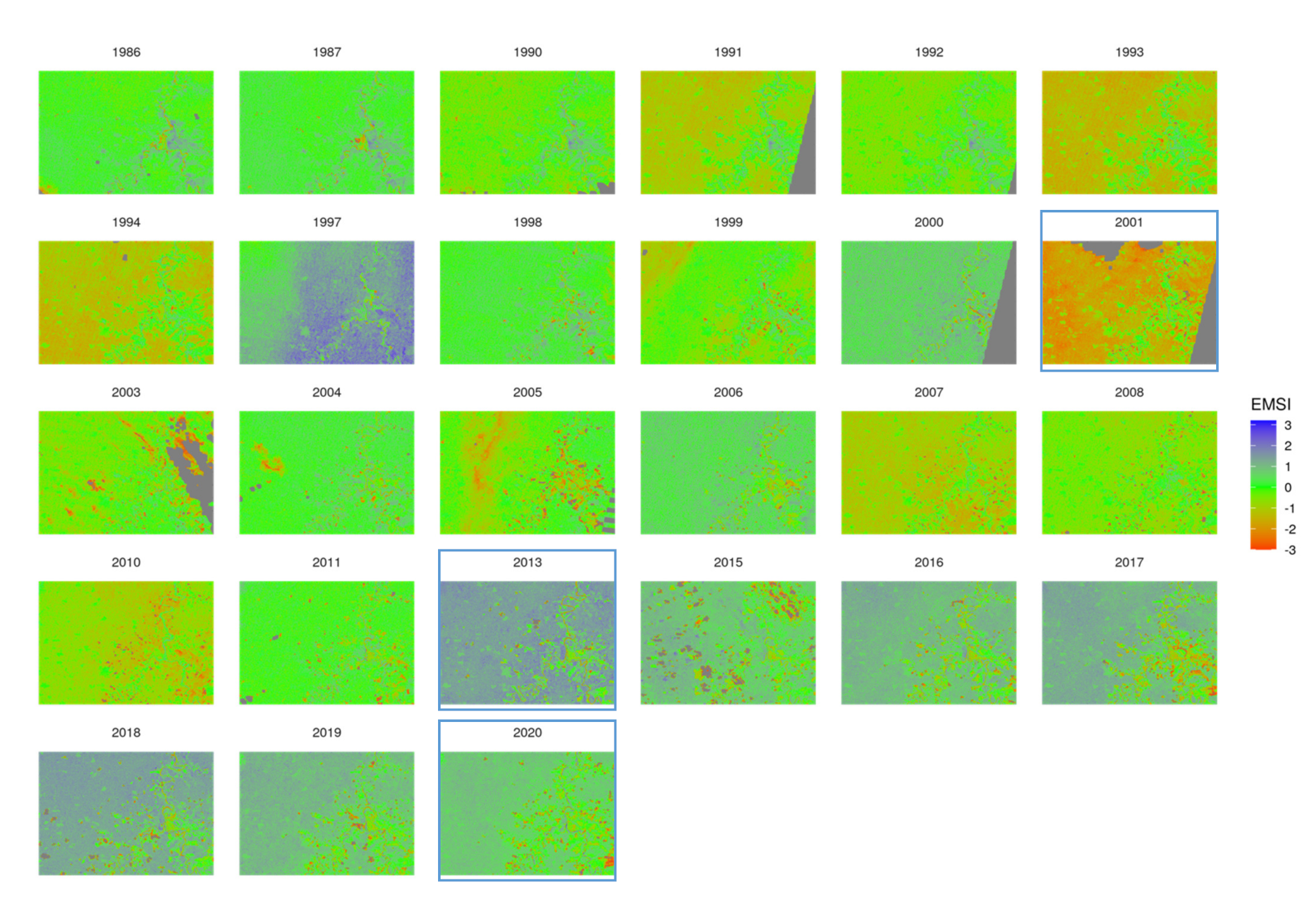
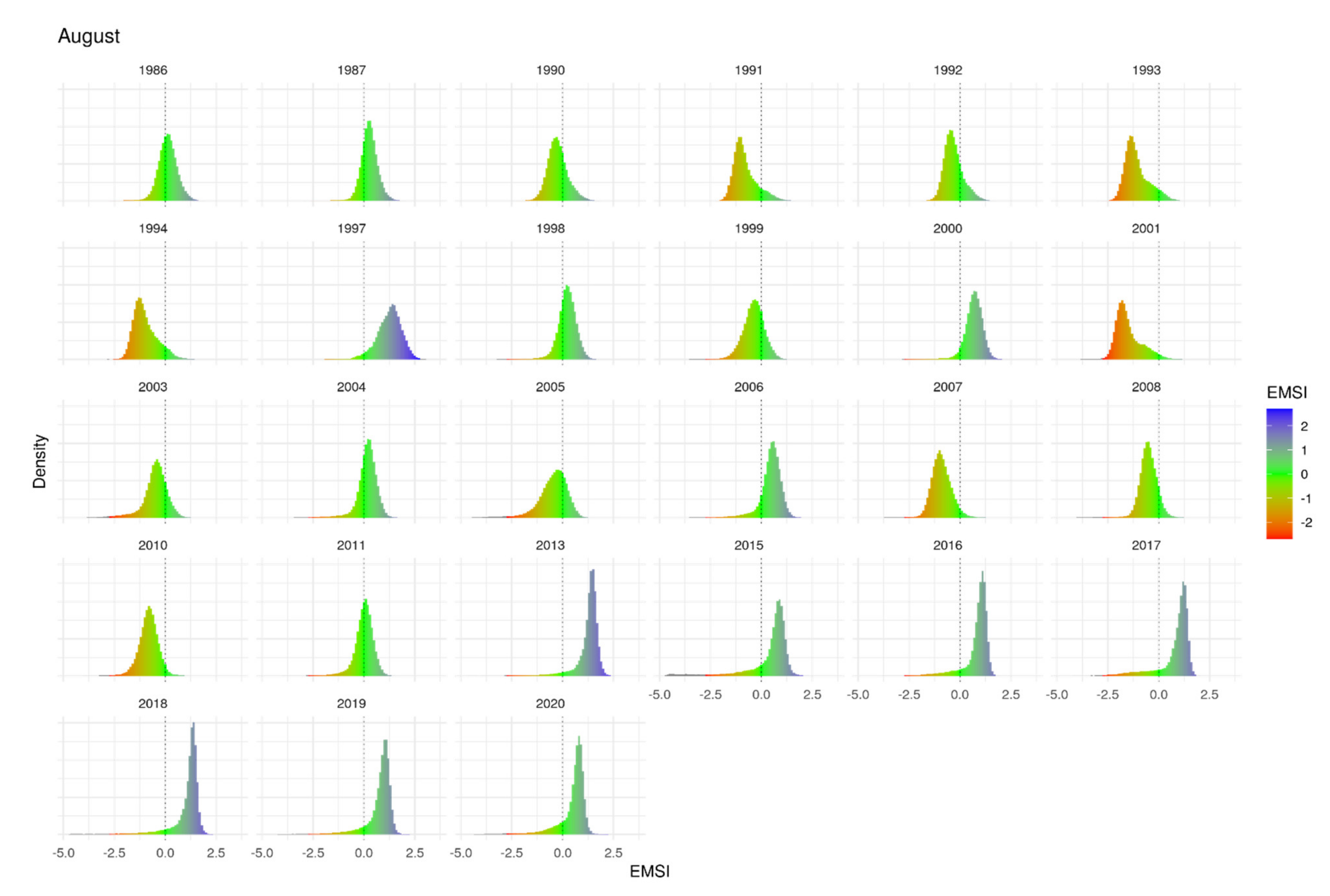
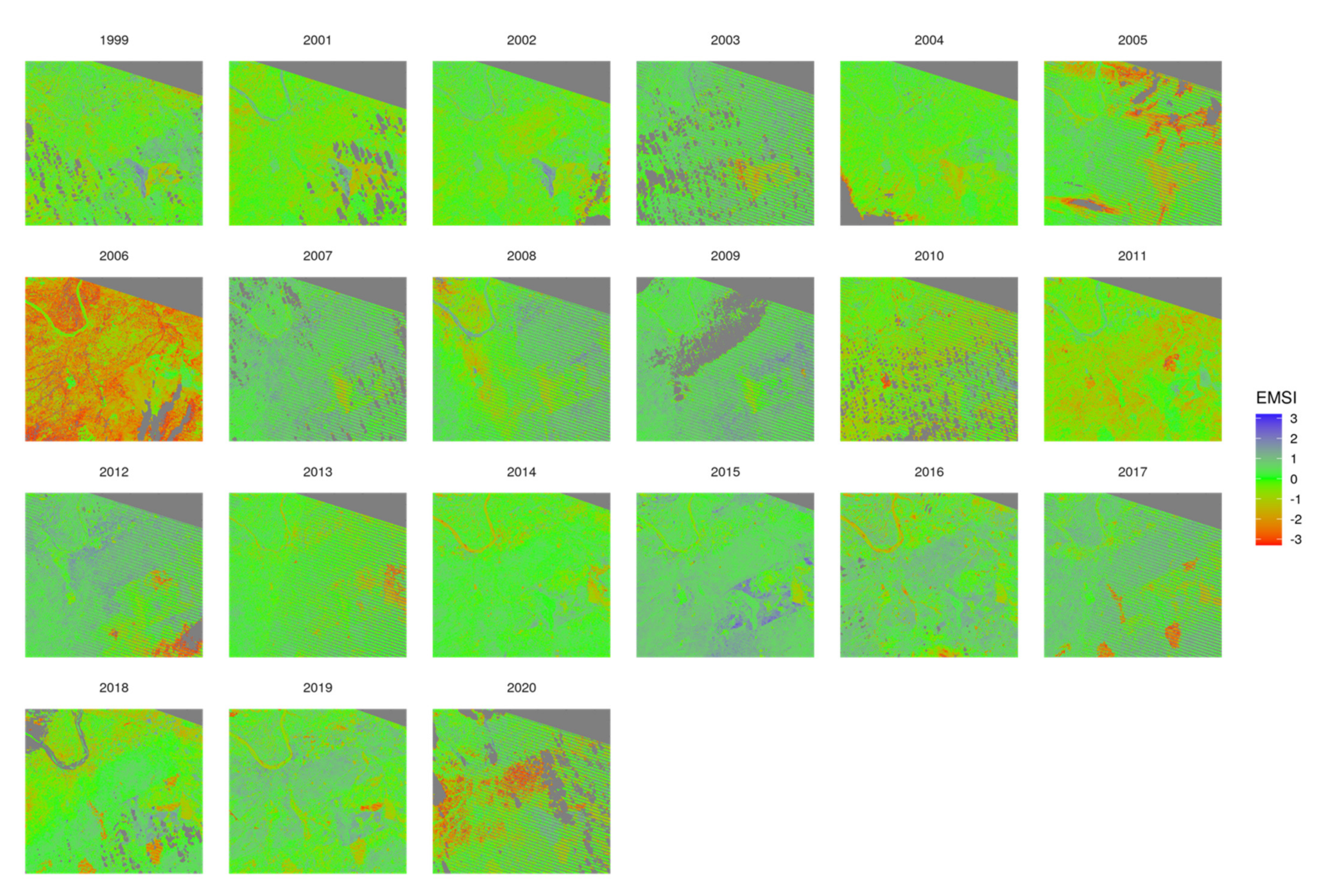
Appendix B
References
- Franklin, J.; Serra-Diaz, J.M.; Syphard, A.D.; Regan, H.M. Global change and terrestrial plant community dynamics. Proc. Natl. Acad. Sci. USA 2016, 113, 3725–3734. [Google Scholar] [CrossRef]
- Kerr, J.T.; Ostrovsky, M. From space to species: Ecological applications for remote sensing. Trends Ecol. Evol. 2003, 18, 299–305. [Google Scholar] [CrossRef]
- Schimel, D.; Pavlick, R.; Fisher, J.B.; Asner, G.P.; Saatchi, S.; Townsend, P.; Miller, C.; Frankenberg, C.; Hibbard, K.; Cox, P. Observing terrestrial ecosystems and the carbon cycle from space. Glob. Change Biol. 2015, 21, 1762–1776. [Google Scholar] [CrossRef] [PubMed]
- Van Leeuwen, W.J.D. Monitoring the effects of forest restoration treatments on post-fire vegetation recovery with MODIS multitemporal data. Sensors 2008, 8, 2017–2042. [Google Scholar] [CrossRef] [PubMed]
- Vogelmann, J.E.; Tolk, B.; Zhu, Z. Monitoring forest changes in the southwestern United States using multitemporal Landsat data. Remote. Sens. Environ. 2009, 113, 1739–1748. [Google Scholar] [CrossRef]
- Vogelmann, J.E.; Xian, G.; Homer, C.; Tolk, B. Monitoring gradual ecosystem change using Landsat time series analyses: Case studies in selected forest and rangeland ecosystems. Remote. Sens. Environ. 2012, 122, 92–105. [Google Scholar] [CrossRef]
- McDowell, N.G.; Coops, N.C.; Beck, P.S.A.; Chambers, J.Q.; Gangodagamage, C.; Hicke, J.A. Global satellite monitoring of climate-induced vegetation disturbances. Trends Plant Sci. 2015, 20, 114–123. [Google Scholar] [CrossRef]
- Houborg, R.; McCabe, M. Daily retrieval of NDVI and LAI at 3 m resolution via the fusion of CubeSat, landsat, and MODIS data. Remote Sens. 2018, 10, 890. [Google Scholar] [CrossRef]
- Johnson, B.R.; McGlinchy, J.; Cattau, M. Harnessing commercial satellite technologies to monitor our forests. In Proceedings of the Remote Sensing and Modeling of of Ecosystems for Sustainability XV, San Diego, CA, USA, 19–23 August 2018; Available online: https://www.spiedigitallibrary.org/conference-proceedings-of-spie/10767/1076702/Harnessing-commercial-satellite-technologies-to-monitor-our-forests/10.1117/12.2321648.short?casa_token=o3QcBn0V_74AAAAA:uxumuIt2Yt2FyyuFNtlG8QcQX0ZBMp50KsikLieXTvc0nbuX-uwLaVV-vPAgDoQKRzFitX0G (accessed on 11 March 2021).
- Smith, W.K.; Reed, S.C.; Cleveland, C.C.; Ballantyne, A.P.; Anderegg, W.R.L.; Wieder, W.R.; Liu, Y.Y.; Running, S.W. Large divergence of satellite and Earth system model estimates of global terrestrial CO2 fertilization. Nat. Clim. Change 2016, 6, 306–310. [Google Scholar] [CrossRef]
- Sun, Y.; Frankenberg, C.; Wood, J.D.; Schimel, D.S.; Jung, M.; Guanter, L.; Drewry, D.T.; Verma, M.; Porcar-Castell, A.; Griffis, T.J.; et al. OCO-2 advances photosynthesis observation from space via solar-induced chlorophyll fluorescence. Science 2017, 358, eaam5747. [Google Scholar] [CrossRef]
- Miller, J.D.; Thode, A.E. Quantifying burn severity in a heterogeneous landscape with a relative version of the delta Normalized Burn Ratio (dNBR). Remote. Sens. Environ. 2007, 109, 66–80. [Google Scholar] [CrossRef]
- Giglio, L.; Randerson, J.T.; van der Werf, G.R. Analysis of daily, monthly, and annual burned area using the fourth-generation global fire emissions database (GFED4). J. Geophys. Res. Biogeosci. 2013, 118, 317–328. [Google Scholar] [CrossRef]
- Goodwin, N.R.; Coops, N.C.; Wulder, M.A.; Gillanders, S.; Schroeder, T.A.; Nelson, T. Estimation of insect infestation dynamics using a temporal sequence of Landsat data. Remote. Sens. Environ. 2008, 112, 3680–3689. [Google Scholar] [CrossRef]
- Meigs, G.W.; Kennedy, R.E.; Cohen, W.B. A Landsat time series approach to characterize bark beetle and defoliator impacts on tree mortality and surface fuels in conifer forests. Remote. Sens. Environ. 2011, 115, 3707–3718. [Google Scholar] [CrossRef]
- Eklundh, L.; Johansson, T.; Solberg, S. Mapping insect defoliation in Scots pine with MODIS time-series data. Remote. Sens. Environ. 2009, 113, 1566–1573. [Google Scholar] [CrossRef]
- Breshears, D.D.; Cobb, N.S.; Rich, P.M.; Price, K.P.; Allen, C.D.; Balice, R.G. Regional vegetation die-off in response to global-change-type drought. Proc. Natl. Acad. Sci. USA 2005, 102, 15144–15148. [Google Scholar] [CrossRef] [PubMed]
- Allen, C.D.; Macalady, A.K.; Chenchouni, H.; Bachelet, D.; McDowell, N.; Vennetier, M.; Kitzberger, T.; Rigling, A.; Breshears, D.D.; Hogg, E.H.; et al. A global overview of drought and heat-induced tree mortality reveals emerging climate change risks for forests. Forest Ecol. Manag. 2010, 259, 660–684. [Google Scholar] [CrossRef]
- Anderson, L.O.; Malhi, Y.; Aragão, L.E.O.C.; Ladle, R.; Arai, R.; Barbier, N.; Phillips, O. Remote sensing detection of droughts in Amazonian forest canopies. N. Phytol. 2010, 187, 733–750. [Google Scholar] [CrossRef]
- Asner, G.P.; Alencar, A. Drought impacts on the Amazon forest: The remote sensing perspective. N. Phytol. 2010, 187, 569–578. [Google Scholar] [CrossRef]
- Gorelick, N.; Hancher, M.; Dixon, M.; Ilyushchenko, S.; Thau, D.; Moore, R. Google Earth Engine: Planetary-scale geospatial analysis for everyone. Remote Sens. Environ. 2017, 202, 18–27. [Google Scholar] [CrossRef]
- Wilkinson, M.D.; Dumontier, M.; Aalbersberg, I.J.; Appleton, G.; Axton, M.; Baak, A.; Blomberg, N.; Boiten, J.-W.; da Silva-Santos, L.B.; Bourne, P.E.; et al. The FAIR Guiding Principles for scientific data management and stewardship. Sci. Data 2016, 3, 160018. [Google Scholar] [CrossRef] [PubMed]
- Stenseth, N.C.; Ottersen, G.; Hurrell, J.W.; Mysterud, A.; Lima, M.; Chan, K.; Yoccoz, N.G.; Ådlandsvik, B. Review article. Studying climate effects on ecology through the use of climate indices: The North Atlantic Oscillation, El Niño Southern Oscillation and beyond. Proc. R. Soc. B Boil. Sci. 2003, 270, 2087–2096. [Google Scholar] [CrossRef] [PubMed]
- Bowman, D.M.J.S.; Balch, J.K.; Artaxo, P.; Bond, W.J.; Carlson, J.M.; Cochrane, M.A.; D’Antonio, C.M.; DeFries, R.S.; Doyle, J.C.; Harrison, S.P.; et al. Fire in the Earth system. Science 2009, 324, 481–484. [Google Scholar] [CrossRef]
- Breshears, D.D.; Adams, H.D.; Eamus, D.; McDowell, N.G.; Law, D.J.; Will, R.E.; Williams, A.P.; Zou, C.B. The critical amplifying role of increasing atmospheric moisture demand on tree mortality and associated regional die-off. Front. Plant Sci. 2013, 4, 266. [Google Scholar] [CrossRef]
- McDowell, N.G.; Allen, C.D. Darcy’s law predicts widespread forest mortality under climate warming. Nat. Clim. Change 2015, 5, 669–672. [Google Scholar] [CrossRef]
- Allen, C.D.; Breshears, D.D.; McDowell, N.G. On underestimation of global vulnerability to tree mortality and forest die-off from hotter drought in the Anthropocene. Ecosphere 2015, 6, 1–55. [Google Scholar] [CrossRef]
- Monson, R.; Baldocchi, D. Terrestrial Biosphere-Atmosphere Fluxes; Cambridge University Press: Cambridge, UK, 2014. [Google Scholar] [CrossRef]
- Pederson, N.; Hessl, A.E.; Baatarbileg, N.; Anchukaitis, K.J.; di Cosmo, N. Pluvials, droughts, the Mongol Empire, and modern Mongolia. Proc. Natl. Acad. Sci. USA 2014, 111, 4375–4379. [Google Scholar] [CrossRef]
- Park-Williams, A.; Allen, C.D.; Macalady, A.K.; Griffin, D.; Woodhouse, C.A.; Meko, D.M. Temperature as a potent driver of regional forest drought stress and tree mortality. Nat. Clim. Change 2012, 3, 292. [Google Scholar] [CrossRef]
- Zhao, M.; Running, S.W. Drought-induced reduction in global terrestrial net primary production from 2000 through 2009. Science 2010, 329, 940–943. [Google Scholar] [CrossRef]
- Ruthrof, K.X.; Breshears, D.D.; Fontaine, J.B.; Froend, R.H.; Matusick, G.; Kala, J.; Miller, B.P.; Mitchell, P.J.; Wilson, S.K.; van Keulen, M.; et al. Subcontinental heat wave triggers terrestrial and marine, multi-taxa responses. Sci. Rep. 2018, 8, 13094. [Google Scholar] [CrossRef]
- Overpeck, J.T.; Rind, D.; Goldberg, R. Climate-induced changes in forest disturbance and vegetation. Nat. Cell Biol. 1990, 343, 51–53. [Google Scholar] [CrossRef]
- Kangas, R.S.; Brown, T.J. Characteristics of US drought and pluvials from a high-resolution spatial dataset. Int. J. Clim. 2007, 27, 1303–1325. [Google Scholar] [CrossRef]
- Rodriguez-Iturbe, I.; D’Odorico, P.; Porporato, A.; Ridolfi, L. On the spatial and temporal links between vegetation, climate, and soil moisture. Water Resour. Res. 1999, 35, 3709–3722. [Google Scholar] [CrossRef]
- Swetnam, T.W.; Betancourt, J.L. Mesoscale disturbance and ecological response to decadal climatic variability in the American Southwest. J. Clim. 1998, 11, 3128–3147. [Google Scholar] [CrossRef]
- Yool, S.R. Enhancing fire scar anomalies in AVHRR NDVI time-series data. Geocart. Int. 2001, 16, 7–14. [Google Scholar] [CrossRef]
- Goward, S.N.; Markham, B.; Dye, D.G.; Dulaney, W.; Yang, J. Normalized difference vegetation index measurements from the advanced very high resolution radiometer. Remote Sens. Environ. 1991, 35, 257–277. [Google Scholar] [CrossRef]
- Deeming, J.E. National Fire-Danger Rating System; Rocky Mountain Forest and Range Experiment Station, Forest Service, U.S. Department of Agriculture: Washington, DC, USA, 1972.
- Deeming, J.E.; Burgan, R.E.; Cohen, J.D. The National Fire-Danger Rating System—1978; Intermountain Forest and Range Experiment Station, Forest Service, U.S. Department of Agriculture: Washington, DC, USA, 1977.
- Towne, G. Precipitation Influence on Fire Seasons in the Sky Islands of Southeastern Arizona 2000–2011: A Remote Sensing Analysis; Yool, S., Ed.; University of Arizona: Tucson, AZ, USA, 2013. [Google Scholar]
- Peters, A.J.; Walter-Shea, E.A.; Ji, L.; Vina, A.; Hayes, M.; Svoboda, M.D. Drought monitoring with NDVI-based standardized vegetation index. Photogramm. Eng. Remote Sens. 2002, 68, 71–75. [Google Scholar]
- Meroni, M.; Fasbender, D.; Rembold, F.; Atzberger, C.; Klisch, A. Near real-time vegetation anomaly detection with MODIS NDVI: Timeliness vs. accuracy and effect of anomaly computation options. Remote Sens. Environ. 2019, 221, 508–521. [Google Scholar] [CrossRef]
- Hey, T.; Tansley, S.; Tolle, K.M. The Fourth Paradigm: Data-Intensive Scientific Discovery; Microsoft Research: Redmond, WA, USA, 2009. [Google Scholar]
- Hettne, K.M.; Dharuri, H.; Zhao, J.; Wolstencroft, K.; Belhajjame, K.; Soiland-Reyes, S.; Mina, E.; Thompson, M.; Cruickshank, D.; Verdes-Montenegro, L.; et al. Structuring research methods and data with the research object model: Genomics workflows as a case study. J. Biomed. Semant. 2014, 5, 41. [Google Scholar] [CrossRef]
- Hampton, S.E.; Anderson, S.S.; Bagby, S.C.; Gries, C.; Han, X.; Hart, E.M.; Jones, M.B.; Lenhardt, W.C.; Macdonald, A.; Michener, W.K.; et al. The Tao of open science for ecology. Ecosphere 2015, 6, art120. [Google Scholar] [CrossRef]
- Goff, S.A.; Vaughn, M.; McKay, S.; Lyons, E.; Stapleton, A.E.; Gessler, D. The iPlant collaborative: Cyberinfrastructure for plant biology. Front Plant Sci. 2011, 2, 34. [Google Scholar] [CrossRef]
- Merchant, N.; Lyons, E.; Goff, S.; Vaughn, M.; Ware, D.; Micklos, D.; Antin, P. The iPlant collaborative: Cyberinfrastructure for enabling data to discovery for the life sciences. PLoS Biol. 2016, 14, e1002342. [Google Scholar] [CrossRef] [PubMed]
- Devisetty, U.K.; Kennedy, K.; Sarando, P.; Merchant, N.; Lyons, E. Bringing your tools to CyVerse Discovery Environment using docker. F1000Reserch 2016, 5, 1442. [Google Scholar] [CrossRef] [PubMed]
- Chuine, I.; Beaubien, E.G. Phenology is a major determinant of tree species range. Ecol. Lett. 2001, 4, 500–510. [Google Scholar] [CrossRef]
- Miller-Rushing, A.J.; Høye, T.T.; Inouye, D.W.; Post, E. The effects of phenological mismatches on demography. Philos. Trans. R. Soc. B Biol. Sci. 2010, 365, 3177–3186. [Google Scholar] [CrossRef] [PubMed]
- Dwyer, J.; Roy, D.; Sauer, B.; Jenkerson, C.; Zhang, H.; Lymburner, L. Analysis ready data: Enabling analysis of the landsat archive. Remote Sens. 2018, 10, 1363. [Google Scholar]
- Justice, C.; Townshend, J.; Vermote, E.; Masuoka, E.; Wolfe, R.; Saleous, N.; Roy, D.; Morisette, J. An overview of MODIS Land data processing and product status. Remote. Sens. Environ. 2002, 83, 3–15. [Google Scholar] [CrossRef]
- Vermote, E.; Justice, C.; Csiszar, I.; Eidenshink, J.; Myneni, R.; Baret, F.; Masuoka, H.; Wolfe, R.; Claverie, M. NOAA CDR Program. NOAA Climate Data Record (CDR) of Normalized Difference Vegetation Index (NDVI), Version 4 [1982–2014]; NOAA National Climatic Data Center: Washington, DC, USA, 2014.
- Gascon, F.; Cadau, E.; Colin, O.; Hoersch, B.; Isola, C.; López Fernández, B. Copernicus sentinel-2 mission: Products, algorithms and Cal/Val. In Proceedings of the Earth Observing Systems XIX International Society for Optics and Photonics, Baltimore, MD, USA, 6–7 May 2014; p. 92181E. [Google Scholar]
- Gascon, F.; Bouzinac, C.; Thépaut, O.; Jung, M.; Francesconi, B.; Louis, J.; Lonjou, V.; Lafrance, B.; Massera, S.; Gaudel-Vacaresse, A.; et al. Copernicus sentinel-2A calibration and products validation status. Remote Sens. 2017, 9, 584. [Google Scholar] [CrossRef]
- Planet Team. Planet Application Program Interface: In Space for Life on Earth; Planet Labs Inc.: San Francisco, CA, USA, 2017. [Google Scholar]
- Thornton, P.E.; Thornton, M.M.; Mayer, B.W.; Wei, Y.; Devarakonda, R.; Vose, R.S. Daymet: Daily Surface Weather Data on a 1-km grid for North America, Version 3; ORNL DAAC: Oak Ridge, TN, USA, 2017.
- Prism Climate Group. PRISM Climate Data; Oregon State University: Corvallis, OR, USA, 2011. [Google Scholar]
- Fick, S.E.; Hijmans, R.J. WorldClim 2: New 1-km spatial resolution climate surfaces for global land areas. Int. J. Climatol. 2017, 37, 4302–4315. [Google Scholar] [CrossRef]
- Thrasher, B.; Xiong, J.; Wang, W.; Melton, F.; Michaelis, A.; Nemani, R. Downscaled climate projections suitable for resource management. EOS 2013, 94, 321–323. [Google Scholar] [CrossRef]
- Abatzoglou, J.T. Development of gridded surface meteorological data for ecological applications and modelling. Int. J. Clim. 2013, 33, 121–131. [Google Scholar] [CrossRef]
- Masek, J.; Vermote, E.; Saleous, N.; Wolfe, R.; Hall, F.; Huemmrich, K.; Gao, F.; Kutler, J.; Lim, T.-K. A landsat surface reflectance dataset for North America, 1990–2000. IEEE Geosci. Remote. Sens. Lett. 2006, 3, 68–72. [Google Scholar] [CrossRef]
- Masek, J.G.; Vermote, E.F.; Saleous, N.; Wolfe, R.; Hall, F.G.; Huemmrich, F.; Gao, F.; Kutler, J.; Lim, T.K. LEDAPS Calibration, Reflectance, Atmospheric Correction Preprocessing Code, Version 2; ORNL DAAC: Oak Ridge, TN, USA, 2013. Available online: https://daac.ornl.gov/MODELS/guides/LEDAPS_V2.html (accessed on 11 March 2021). [CrossRef]
- Schmidt, G.; Jenkerson, C.B.; Masek, J.; Vermote, E.; Gao, F. Landsat ecosystem disturbance adaptive processing system (LEDAPS) algorithm description. Open File Rep. 2013. [Google Scholar] [CrossRef]
- Foga, S.; Scaramuzza, P.L.; Guo, S.; Zhu, Z.; Dilley, R.D.; Beckmann, T.; Schmidt, G.L.; Dwyer, J.L.; Hughes, M.J.; Laue, B. Cloud detection algorithm comparison and validation for operational Landsat data products. Remote Sens. Environ. 2017, 194, 379–390. [Google Scholar] [CrossRef]
- Vermote, E.; Justice, C.; Csiszar, I. Early evaluation of the VIIRS calibration, cloud mask and surface reflectance Earth data records. Remote Sens Environ. 2014, 148, 134–145. [Google Scholar] [CrossRef]
- Tucker, C.J. Red and photogra phic infrared linear combinations for monitoring vegetation. Remote Sens Environ. 1979, 8, 127–150. [Google Scholar] [CrossRef]
- Hardy, C.C.; Burgan, R.E. Evaluation of NDVI for monitoring live moisture in three vegetation types of the western US. Photogramm. Eng. Remote Sens. 1999, 65, 603–610. [Google Scholar]
- Wang, L.; Hunt, E.R.; Qu, J.J.; Hao, X.; Daughtry, C.S. Remote sensing of fuel moisture content from ratios of narrow-band vegetation water and dry-matter indices. Remote Sens. Environ. 2013, 129, 103–110. [Google Scholar] [CrossRef]
- Jackson, T.J.; Chen, D.; Cosh, M.; Li, F.; Anderson, M.; Walthall, C. Vegetation water content mapping using Landsat data derived normalized difference water index for corn and soybeans. Remote Sens. Environ. 2004, 92, 475–482. [Google Scholar] [CrossRef]
- Pettorelli, N.; Vik, J.O.; Mysterud, A.; Gaillard, J.-M.; Tucker, C.J.; Stenseth, N.C. Using the satellite-derived NDVI to assess ecological responses to environmental change. Trends Ecol. Evol. 2005, 20, 503–510. [Google Scholar] [CrossRef]
- Tucker, C.J.; Pinzon, J.E.; Brown, M.E.; Slayback, D.A.; Pak, E.W.; Mahoney, R.; Vermote, E.F.; el Saleous, N. An extended AVHRR 8-km NDVI dataset compatible with MODIS and SPOT vegetation NDVI data. Int. J. Remote. Sens. 2005, 26, 4485–4498. [Google Scholar] [CrossRef]
- Pettorelli, N. The Normalized Difference Vegetation Index; OUP Oxford: Oxford, UK, 2013. [Google Scholar]
- Thenkabail, P.S.; Lyon, J.G. Hyperspectral Remote Sensing of Vegetation; CRC Press: Boca Raton, FL, USA, 2016. [Google Scholar]
- Team, R. RStudio: Integrated Development for R.; RStudio Inc.: Boston, MA, USA, 2015; Available online: http://www.rstudio.com (accessed on 11 March 2021).
- Gandrud, C. Reproducible Research with R and R Studio. 2016. Available online: https://www.taylorfrancis.com/books/9781498715386 (accessed on 11 March 2021).
- Merkel, D. Docker: Lightweight Linux Containers for Consistent Development and Deployment. 2014. Available online: http://dl.acm.org/citation.cfm?id=2600239.2600241 (accessed on 11 March 2021).
- Beaulieu-Jones, B.K.; Greene, C.S. Reproducibility of computational workflows is automated using continuous analysis. Nat. Biotechnol. 2017, 35, 342–346. [Google Scholar] [CrossRef] [PubMed]
- Boettiger, C.; Eddelbuettel, D. An introduction to rocker: Docker containers for R. R J. 2017, 9, 527–536. [Google Scholar] [CrossRef]
- Nüst, D.; Boettiger, C.; Eddelbuettel, D. Rocker/Geospatial: A Flexible Runtime Environment for Geoscientific Data Analysis. 2018. Available online: https://ui.adsabs.harvard.edu/ (accessed on 11 March 2021).
- Nüst, D.; Eddelbuettel, D.; Bennett, D.; Cannoodt, R.; Clark, D.; Daroczi, G.; Edmondson, M.; Fay, C.; Hughes, E.; Kjeldgaard, L.; et al. The Rockerverse: Packages and Applications for Containerization with R. arXiv 2001, arXiv:2001.10641. Available online: https://arxiv.org/abs/2001.10641 (accessed on 11 March 2021).
- Chambers, J. Software for Data Analysis: Programming with R; Springer: New York, NY, USA, 2008. [Google Scholar]
- Canty, A.; Ripley, B. Boot: Bootstrap R (S-Plus) Functions; R Package Version; RStudio Inc.: Boston, MA, USA, 2012. [Google Scholar]
- Petris, G. An R package for dynamic linear models. J. Stat. Softw. 2010, 36, 1–16. [Google Scholar] [CrossRef]
- Wickham, H.; Hester, J.; Chang, W. Devtools: Tools to Make Developing R Packages Easier; R Package Version 1.13; RStudio Inc.: Boston, MA, USA, 2018. [Google Scholar]
- Tang, Y.; Horikoshi, M.; Li, W. Ggfortify: Unified interface to visualize statistical result of popular R packages. R J. 2016, 8, 474–485. [Google Scholar] [CrossRef]
- Wickham, H. ggplot2: Elegant Graphics for Data Analysis; Springer: Berlin/Heidelberg, Germany, 2016. [Google Scholar]
- Wickham, H.; Chang, W.; Henry, L.; Pedersen, T.L.; Takahashi, K.; Wilke, C.; Woo, K.; Yutani, H.; Dunnington, D. ggplot2: An Implementation of the Grammar of Graphics; R Package Version 0 7. Available online: https://cran.r-project.org/web/packages/ggplot2/index.html (accessed on 11 March 2021).
- Auguie, B.; Antonov, A.; Auguie, M.B. Package ‘gridExtra.’ Miscellaneous Functions for “Grid” Graphics. 2017. Available online: ftp://ftp.musicbrainz.org/pub/cran/web/packages/gridExtra/gridExtra.pdf (accessed on 11 March 2021).
- Team RC. Foreign: Read Data Stored by Minitab, S, SAS, SPSS, Stata, Systat, Weka, dBase; R Package Version 0 8-66; RStudio Inc.: Boston, MA, USA, 2018. [Google Scholar]
- Xie, Y. Knitr: A Comprehensive Tool for Reproducible Research in R. Implement Reprod. Res. 2014, 1, 20. [Google Scholar]
- Graul, C.; Graul, M.C. Package ‘leafletR.’ 2016. Available online: http://cran.uvigo.es/web/packages/leafletR/leafletR.pdf (accessed on 11 March 2021).
- Grolemund, G.; Wickham, H. Dates and times made easy with lubridate. J. Stat. Softw. 2011, 40, 1–25. [Google Scholar] [CrossRef]
- Peterson, B.G.; Carl, P.; Boudt, K.; Bennett, R.; Ulrich, J.; Zivot, E. Performance Analytics: Econometric Tools for Performance and Risk Analysis; R Package Version; RStudio Inc.: Boston, MA, USA, 2014. [Google Scholar]
- Sievert, C.; Parmer, C.; Hocking, T.; Chamberlain, S.; Ram, K.; Corvellec, M. plotly: Create Interactive Web Graphics via “plotly. js”; R Package Version; RStudio Inc.: Boston, MA, USA, 2016. [Google Scholar]
- Hijmans, R.J.; van Etten, J.; Sumner, M.; Cheng, J.; Baston, D.; Bevan, A.; Bivand, R.; Busetto, L.; Canty, M.; Fasoli, B.; et al. Package ‘raster.’ Geographic Data Analysis and Modeling. R Package. 2015, 734. Available online: ftp://h64-50-233-100.mdsnwi.tisp.static.tds.net/pub/cran/web/packages/raster/raster.pdf (accessed on 11 March 2021).
- Bivand, R.; Keitt, T.; Rowlingson, B.; Pebesma, E.; Sumner, M.; Hijmans, R.; Baston, D.; Rouault, E.; Warmerdam, F.; Ooms, J.; et al. Package ‘rgdal.’ Bindings for the Geospatial Data Abstraction Library. 2015. Available online: http://mirror.psu.ac.th/pub/cran/web/packages/rgdal/rgdal.pdf (accessed on 11 March 2021).
- Allaire, J.J.; Cheng, J.; Xie, Y.; McPherson, J.; Chang, W.; Allen, J. rmarkdown: Dynamic Documents for R; R Package Version; RStudio Inc.: Boston, MA, USA, 2016. [Google Scholar]
- Pebesma, E.; Bivand, R.; Pebesma, M.E.; RColorBrewer, S; Collate, A.A.A. Package ‘sp.’ The Comprehensive R Archive Network. 2012. Available online: http://citeseerx.ist.psu.edu/viewdoc/download?doi=10.1.1.394.5403&rep=rep1&type=pdf (accessed on 11 March 2021).
- Cleveland, W.S.; Devlin, S.J. Locally weighted regression: An approach to regression analysis by local fitting. J. Am. Stat. Assoc. 1988, 83, 596–610. [Google Scholar] [CrossRef]
- Crate, S.; Ulrich, M.; Habeck, J.O.; Desyatkin, A.R.; Desyatkin, R.V.; Fedorov, A.N.; Hiyama, T.; Iijima, Y.; Ksenofontov, S.; Mészáros, C.; et al. Permafrost livelihoods: A transdisciplinary review and analysis of thermokarst-based systems of indigenous land use. Anthropocene 2017, 18, 89–104. [Google Scholar] [CrossRef]
- Beck, H.E.; Zimmermann, N.E.; McVicar, T.R.; Vergopolan, N.; Berg, A.; Wood, E.F. Present and future Köppen-Geiger climate classification maps at 1-km resolution. Sci. Data 2018, 5, 180214. [Google Scholar] [CrossRef]
- Smith, L.T.; Aragão, L.E.O.C.; Sabel, C.E.; Nakaya, T. Drought impacts on children’s respiratory health in the Brazilian Amazon. Sci. Rep. 2015, 4, 3726. [Google Scholar] [CrossRef]
- Smith, M.N.; Stark, S.C.; Taylor, T.C.; Ferreira, M.L.; de Oliveira, E.; Restrepo-Coupe, N.; Chen, S.; Woodcock, T.; dos Santos, D.B.; Alves, L.F.; et al. Seasonal and drought-related changes in leaf area profiles depend on height and light environment in an Amazon forest. N. Phytol. 2019, 222, 1284–1297. [Google Scholar] [CrossRef]
- Cavazos, T.; Comrie, A.C.; Liverman, D.M. Intraseasonal variability associated with wet monsoons in Southeast Arizona. J. Clim. 2002, 15, 2477–2490. [Google Scholar] [CrossRef]
- Scott, R.L.; Biederman, J.A.; Hamerlynck, E.P.; Barron-Gafford, G.A. The carbon balance pivot point of southwestern U.S. semiarid ecosystems: Insights from the 21st century drought. J. Geophys. Res. Biogeosci. 2015, 120, 2612–2624. [Google Scholar] [CrossRef]
- Weiss, J.L.; Castro, C.L.; Overpeck, J.T. Distinguishing pronounced droughts in the Southwestern United States: Seasonality and effects of warmer temperatures. J. Clim. 2009, 22, 5918–5932. [Google Scholar] [CrossRef]
- McCarthy, T.S.; Cooper, G.R.J.; Tyson, P.D.; Ellery, W.N. Seasonal flooding in the Okavango Delta, Botswana-recent history and future prospects. S. Afr. J. Sci. 2000, 96, 25–33. [Google Scholar]
- Brown, M.E.; de Beurs, K.M. Evaluation of multi-sensor semi-arid crop season parameters based on NDVI and rainfall. Remote Sens. Environ. 2008, 112, 2261–2271. [Google Scholar] [CrossRef]
- Fensholt, R.; Rasmussen, K.; Nielsen, T.T.; Mbow, C. Evaluation of earth observation based long term vegetation trends—Intercomparing NDVI time series trend analysis consistency of Sahel from AVHRR GIMMS, Terra MODIS and SPOT VGT data. Remote Sens. Environ. 2009, 113, 1886–1898. [Google Scholar] [CrossRef]
- Yengoh, G.T.; Dent, D.; Olsson, L.; Tengberg, A.E.; Tucker, C.J., III. Use of the Normalized Difference Vegetation Index (NDVI) to Assess Land Degradation at Multiple Scales: Current Status, Future Trends, and Practical Considerations; Springer: Berlin/Heidelberg, Germany, 2015. [Google Scholar]
- Burgan, R.E.; Hartford, R.A. Monitoring Vegetation Greenness with Satellite Data. 1993. Available online: https://www.fs.usda.gov/treesearch/pubs/43784 (accessed on 11 March 2021).
- Burgan, R.E.; Hartford, R.A.; Eidenshink, J.C. Using NDVI to Assess Departure from Average Greenness and Its Relation To Fire Business. 1996. Available online: https://www.fs.fed.us/rm/pubs_int/int_gtr333.pdf (accessed on 11 March 2021).
- Newnham, G.J.; Verbesselt, J.; Grant, I.F.; Anderson, S.A. Relative greenness index for assessing curing of grassland fuel. Remote Sens. Environ. 2011, 115, 1456–1463. [Google Scholar] [CrossRef]
- Schneider, P.; Roberts, D.; Kyriakidis, P. A VARI-based relative greenness from MODIS data for computing the Fire Potential Index. Remote Sens. Environ. 2008, 112, 1151–1167. [Google Scholar] [CrossRef]
- LeBlon, B. Forest wildfire hazard monitoring using remote sensing: A review. Remote Sens. Rev. 2001, 20, 1–43. [Google Scholar] [CrossRef]
- Gao, B.-C. NDWI—A normalized difference water index for remote sensing of vegetation liquid water from space. Remote Sens. Environ. 1996, 58, 257–266. [Google Scholar] [CrossRef]
- Huntington, J.L.; Hegewisch, K.C.; Daudert, B.; Morton, C.G.; Abatzoglou, J.T.; McEvoy, D.J.; Erickson, T. Climate engine: Cloud computing and visualization of climate and remote sensing data for advanced natural resource monitoring and process understanding. Bull. Am. Meteorol. Soc. 2017, 98, 2397–2410. [Google Scholar] [CrossRef]
- Anees, A.; Aryal, J. Near-real time detection of beetle infestation in pine forests using MODIS data. IEEE J. Sel. Top. Appl. Earth Obs. Remote Sens. 2014, 7, 3713–3723. [Google Scholar] [CrossRef]
- Anees, A.; Aryal, J.; O’Reilly, M.M.; Gale, T.J. A relative density ratio-based framework for detection of land cover changes in MODIS NDVI time series. IEEE J. Sel. Top. Appl. Earth Obs. Remote Sens. 2015, 9, 3359–3371. [Google Scholar] [CrossRef]
- Chakraborty, S.; Banerjee, A.; Gupta, S.; Papandreou-Suppappola, A.; Christensen, P. Estimation of dynamic parameters of MODIS NDVI time series nonlinear model using particle filtering. In Proceedings of the 2017 IEEE International Geoscience and Remote Sensing Symposium (IGARSS), Fort Worth, TX, USA, 23–28 July 2017; pp. 1091–1094. [Google Scholar] [CrossRef]
- Anees, A.; Aryal, J.; O’Reilly, M.M.; Gale, T.J.; Wardlaw, T. A robust multi-kernel change detection framework for detecting leaf beetle defoliation using Landsat 7 ETM+ data. ISPRS J. Photogramm. Remote. Sens. 2016, 122, 167–178. [Google Scholar] [CrossRef]
- Westerling, A.L.; Hidalgo, H.G.; Cayan, D.R.; Swetnam, T.W. Warming and earlier spring increase Western U.S. Forest Wildfire activity. Science 2006, 313, 940–943. [Google Scholar] [CrossRef]
- Westerling, A.L. Increasing western US forest wildfire activity: Sensitivity to changes in the timing of spring. Philos. Trans. R. Soc. B Biol. Sci. 2016, 371, 20150178. [Google Scholar] [CrossRef]
- Kitzberger, T.; Falk, D.A.; Westerling, A.L.; Swetnam, T.W. Direct and indirect climate controls predict heterogeneous early-mid 21st century wildfire burned area across western and boreal North America. PLoS ONE 2017, 12, e0188486. [Google Scholar] [CrossRef]
- Singleton, M.P.; Thode, A.E.; Meador, A.J.S.; Iniguez, J.M. Increasing trends in high-severity fire in the southwestern USA from 1984 to 2015. Forest Ecol. Manag. 2019, 433, 709–719. [Google Scholar] [CrossRef]
- Holden, Z.A.; Morgan, P.; Crimmins, M.A.; Steinhorst, R.K.; Smith, A. Fire season precipitation variability influences fire extent and severity in a large southwestern wilderness area, United States. Geophys. Res. Lett. 2007, 34, 16708. [Google Scholar] [CrossRef]
- Holden, Z.A.; Swanson, A.; Luce, C.H.; Jolly, W.M.; Maneta, M.; Oyler, J.W.; Warren, D.A.; Parsons, R.; Affleck, D. Decreasing fire season precipitation increased recent western US forest wildfire activity. Proc. Natl. Acad. Sci. USA 2018, 115, E8349–E8357. [Google Scholar] [CrossRef] [PubMed]
- Abatzoglou, J.T.; Kolden, C.A.; Williams, A.P.; Lutz, J.A.; Smith, A.M.S. Climatic influences on interannual variability in regional burn severity across western US forests. Int. J. Wildland Fire 2017, 26, 269–275. [Google Scholar] [CrossRef]
- Eamus, D.; Boulain, N.; Cleverly, J. Global Change-Type Drought-Induced Tree Mortality: Vapor Pressure Deficit is More Important than Temperature per se in Causing Decline in tree Health. 2013. Available online: http://onlinelibrary.wiley.com/doi/10.1002/ece3.664/full (accessed on 11 March 2021).
- Ficklin, D.L.; Novick, K.A. Historic and projected changes in vapor pressure deficit suggest a continental-scale drying of the United States atmosphere. J. Geophys. Res. Atmos. 2017, 122, 2061–2079. [Google Scholar] [CrossRef]
- Brodrick, P.G.; Asner, G. Remotely sensed predictors of conifer tree mortality during severe drought. Environ. Res. Lett. 2017, 12, 115013. [Google Scholar] [CrossRef]
- Young, D.J.N.; Stevens, J.T.; Earles, J.M.; Moore, J.; Ellis, A.; Jirka, A.L.; Latimer, A.M. Long-term climate and competition explain forest mortality patterns under extreme drought. Ecol. Lett. 2017, 20, 78–86. [Google Scholar] [CrossRef] [PubMed]
- Van Mantgem, P.J.; Falk, D.A.; Williams, E.C.; Das, A.J.; Stephenson, N.L. Pre-fire drought and competition mediate post-fire conifer mortality in western U.S. National Parks. Ecol. Appl. 2018, 28, 1730–1739. [Google Scholar] [CrossRef]
- Van Mantgem, P.J.; Falk, D.A.; Williams, E.C.; Das, A.J.; Stephenson, N.L. The influence of pre-fire growth patterns on post-fire tree mortality for common conifers in western US parks. Int. J. Wildland Fire 2020, 29, 513–518. [Google Scholar] [CrossRef]
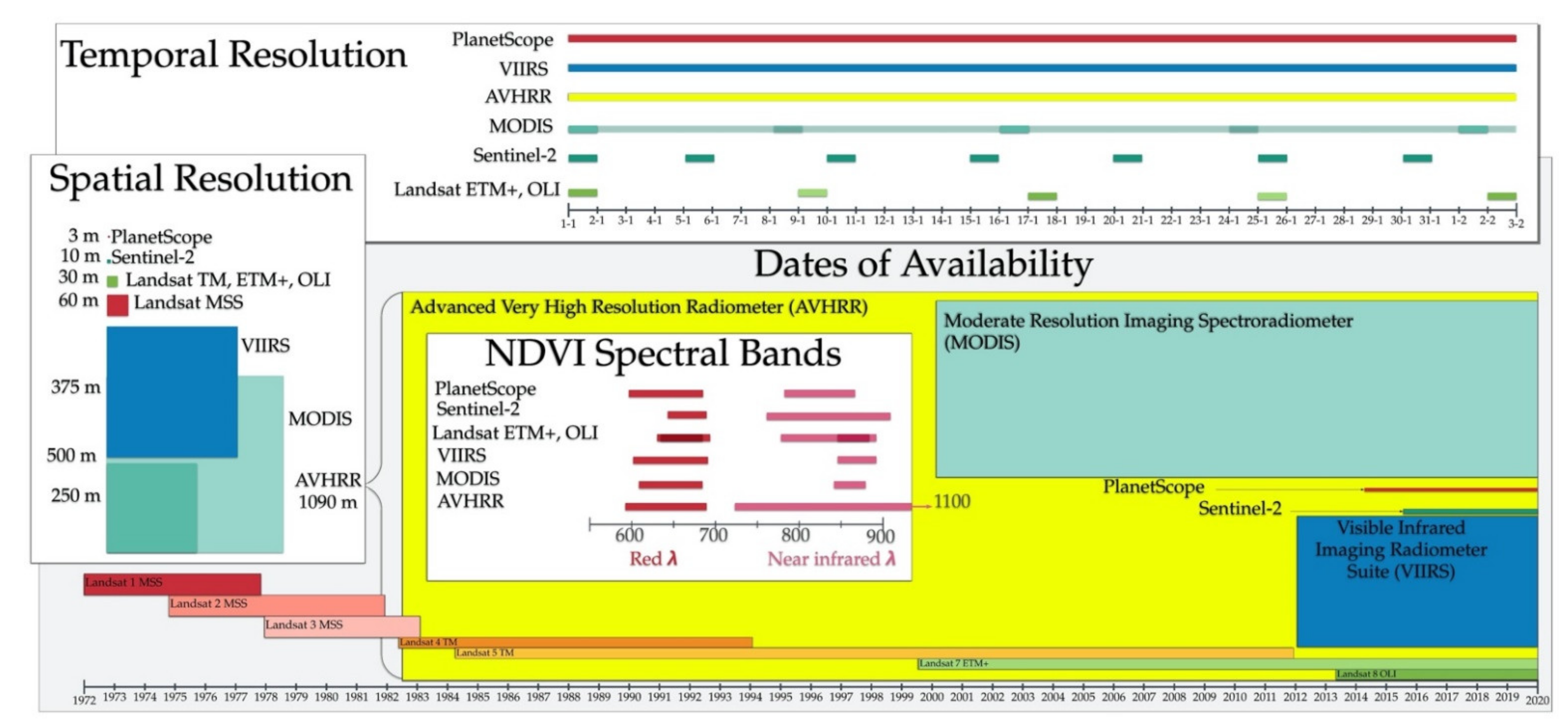
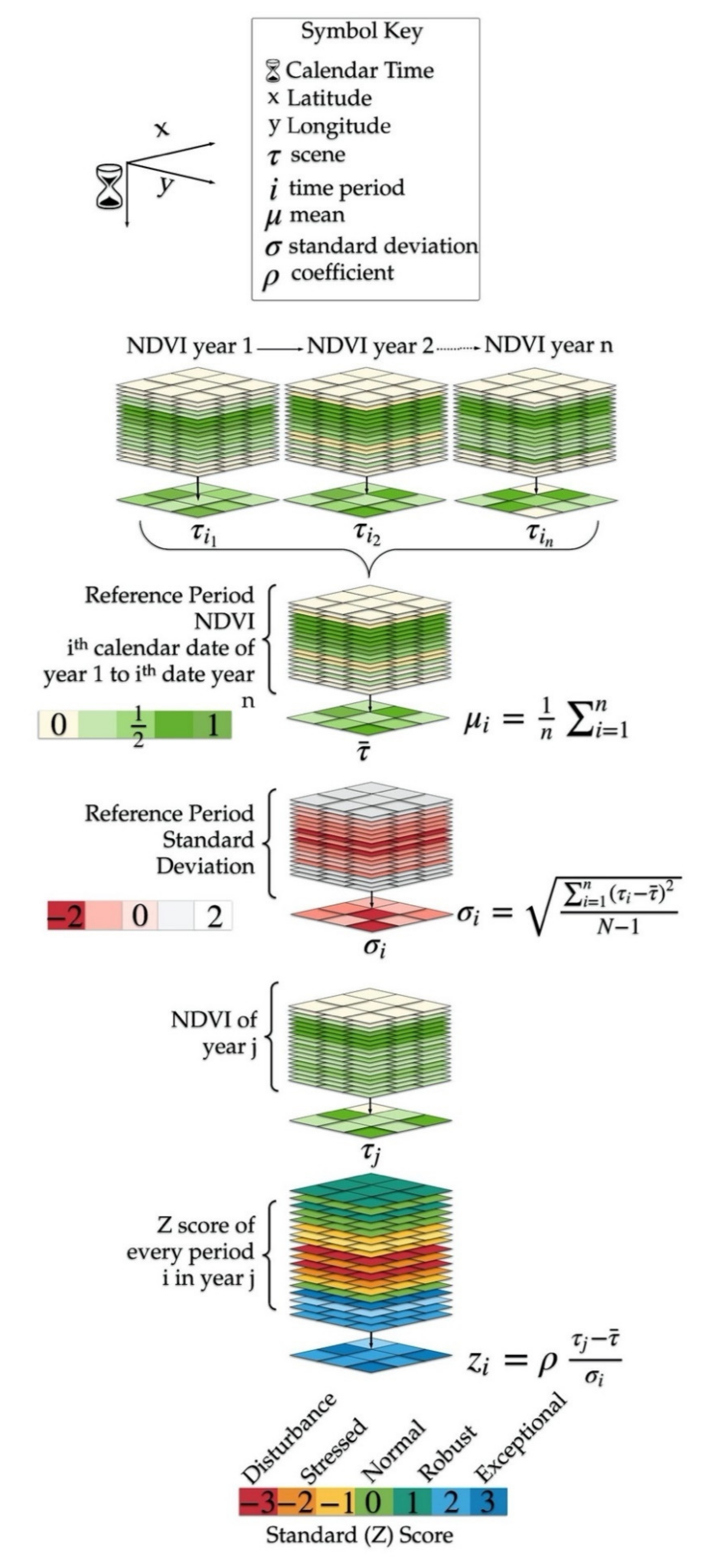
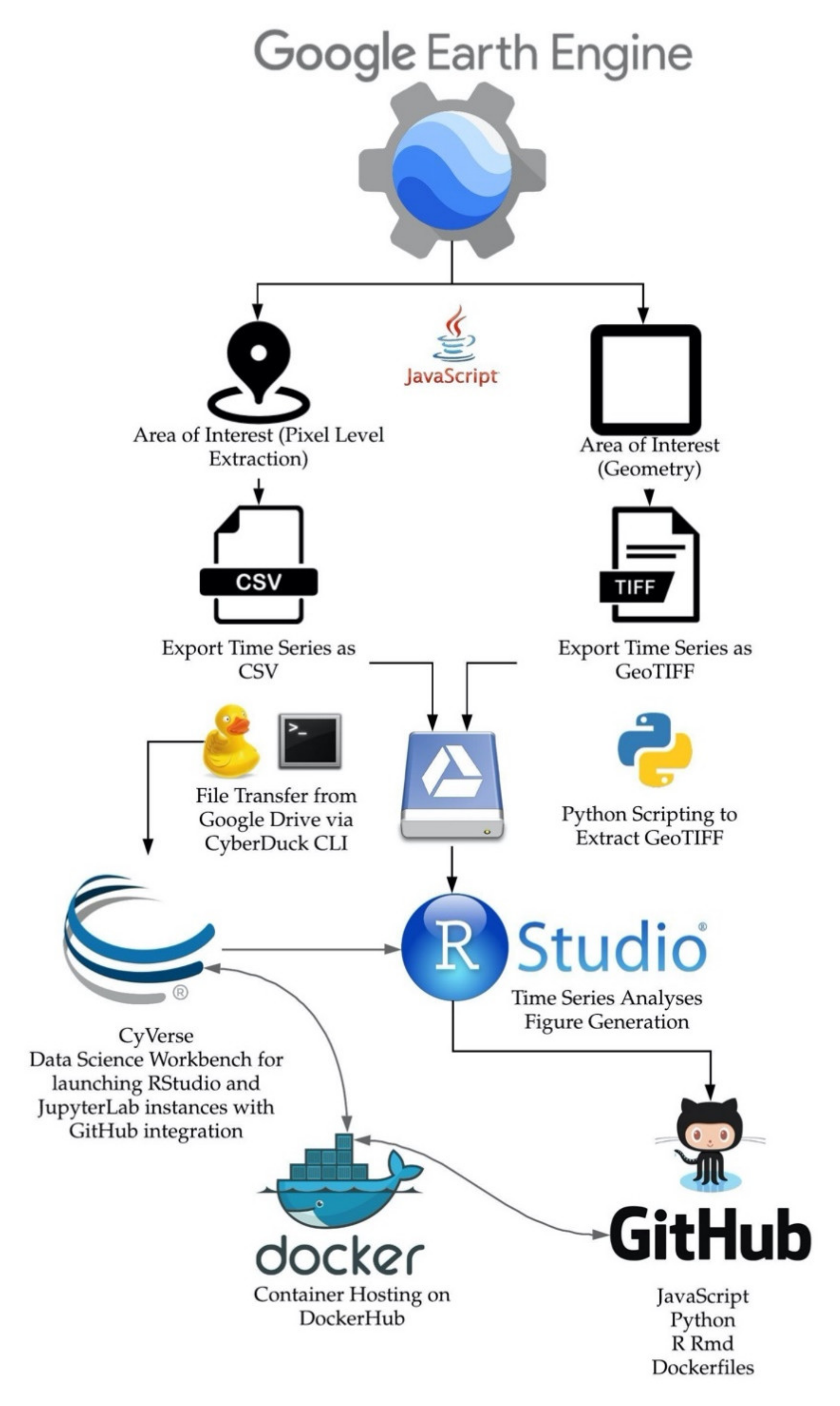

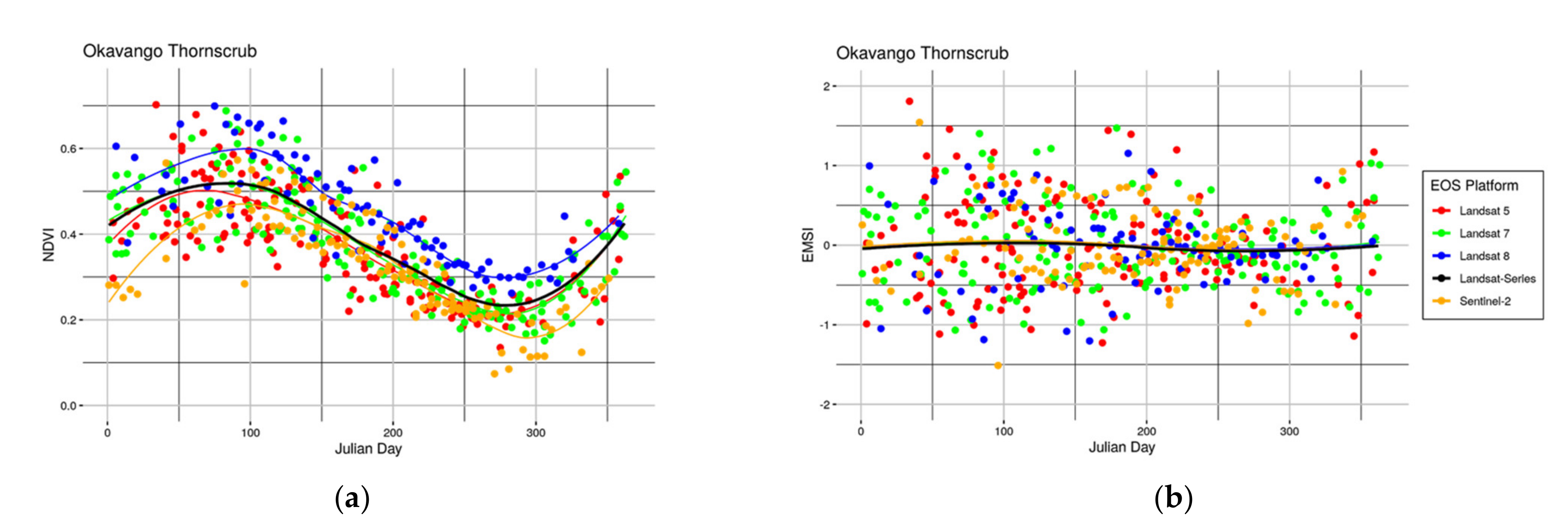

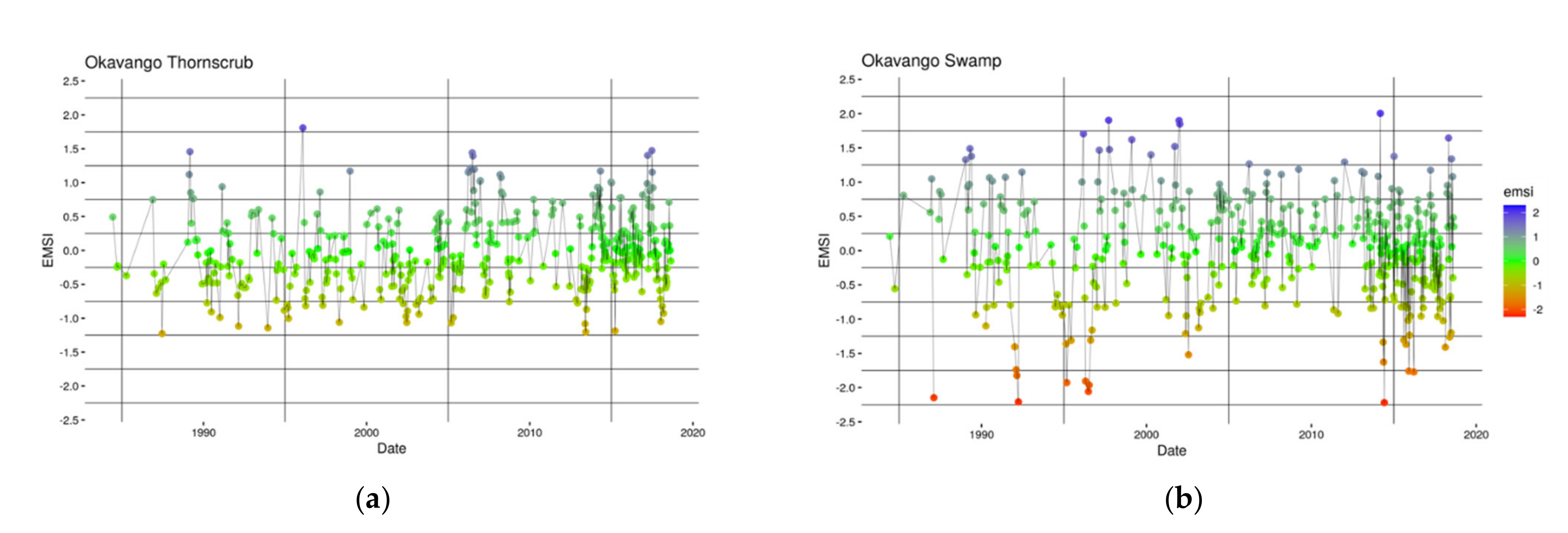

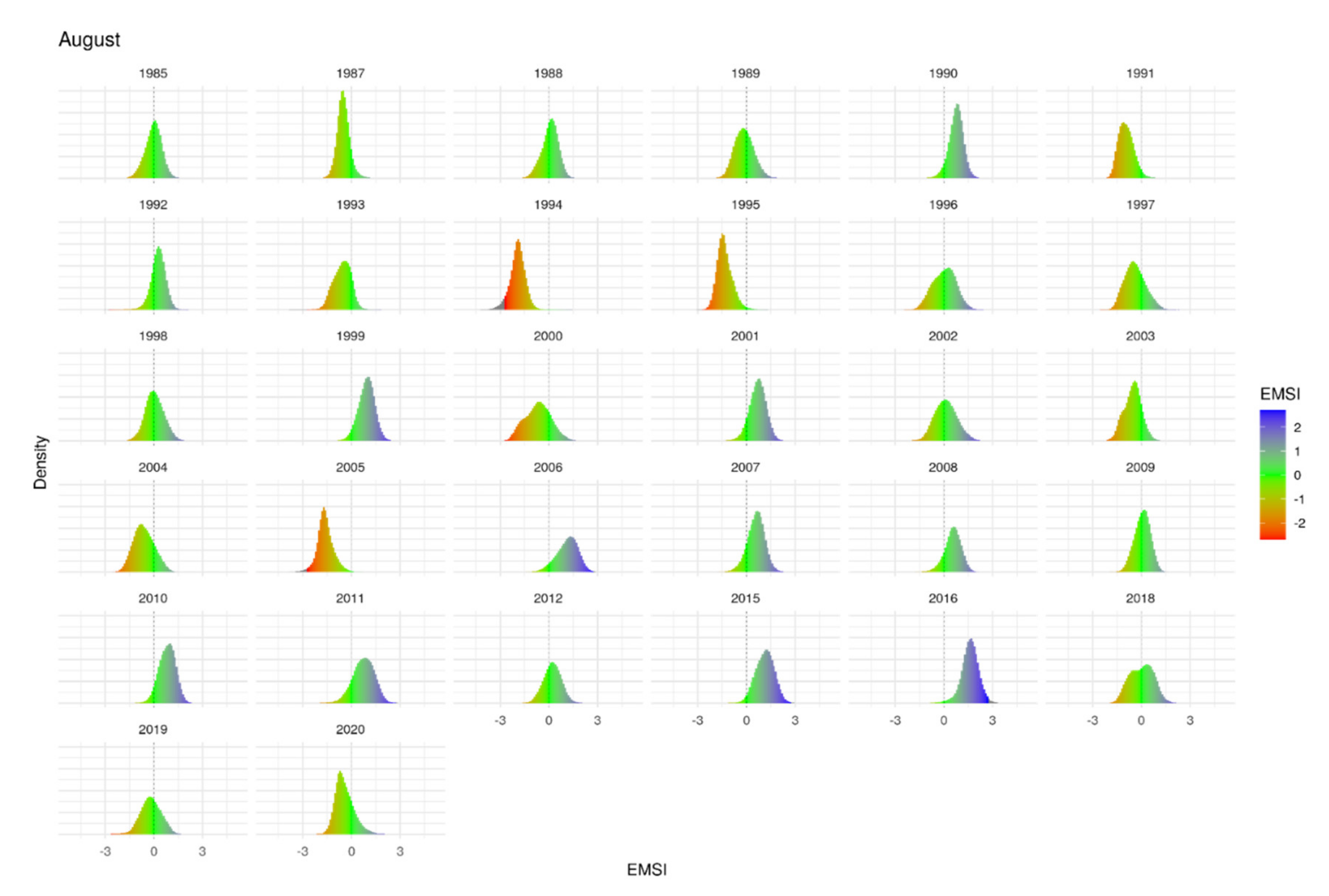

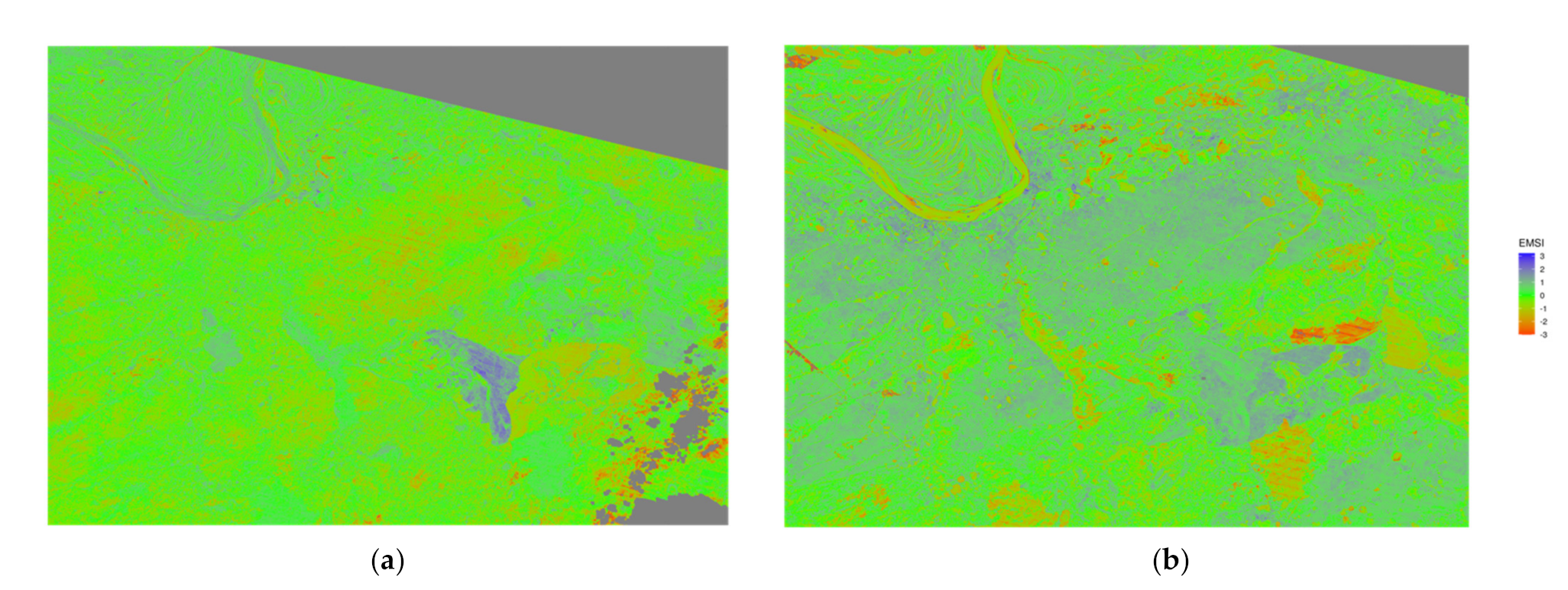
| Satellite 1 | Red (nm) (Band) | NIR (nm) (Band) | Spatial (m2) | Temporal (day−1) | Dates (month/years) |
|---|---|---|---|---|---|
| Landsat 1 MSS | 600–700 (B5) | 700–800 (B6) | 60 | 16 | 07/1972–01/1978 |
| Landsat 2 MSS | 600–700 (B5) | 700–800 (B6) | 60 | 16 | 01/1975–02/1982 |
| Landsat 3 MSS | 600–700 (B5) | 700–800 (B6) | 60 | 16 | 03/1978–03/1983 |
| Landsat 4 TM | 630–690 (B3) | 770–900 (B4) | 30 | 16 | 08/1982–12/1993 |
| Landsat 5 TM | 630–690 (B3) | 770–900 (B4) | 30 | 16 | 04/1984–11/2011 |
| Landsat 7 ETM+ | 631–692 (B3) | 772–898 (B4) | 30 | 16 | 06/1999–Present |
| Landsat 8 OLI | 636–673 (B4) | 851–879 (B2) | 30 | 16 | 04/2013–Present |
| MODIS | 620–670 (1) | 841–876 (B2) | 250/500 | 8/16 | 02/2000–Present |
| AVHRR | 580–680 (B1) | 725–1100 (B2) | 1090 | 1 | 06/1981–Present |
| VIIRS | 600–680 (B I1) | 846–885 (B I2) | 375/500 | 1 | 01/2012–Present |
| PlanetScope 2 | 590–670 (B3) | 780–860 (B4) | 3 | 1 | 07/2014–Present |
| Sentinel-2 | 645–684 (B4) | 763–907 (B8) | 10 | 5 | 07/2015–Present |
| Index | Ecological State | Characteristics |
|---|---|---|
| z ≤ −2.0 | In Collapse, Disturbed, or Misclassified | Spatial extents that have recently undergone a major disturbance, such as land clearing, overgrazing, or wildfire, exceeding 95% of all historical observations used in the reference |
| −2.0 < z < −1.0 | Degrading or highly stressed | Spatial extents exhibit significant departure from normal conditions, likely due to extreme moisture stress, severe drought, or herbivory. |
| −1.0 ≤ z ≤ 1.0 | Stable or Normal conditions | Variation falls within one standard deviation, meaning conditions are most common for that date or period. |
| 1.0 < z < 2.0 | Improving or Robust | Spatial extent is undergoing a surplus or pluvial-like condition with enhanced greenness or new growth. |
| 2.0 ≤ z | Exceptional or Type Conversion | Exceeds 95% of all historic observations in the reference period. May indicate recovery from collapsed state, or conversion to an altered use. |
| .js Explorer | Reflectance Product SR/TOA/Raw | Processing Algorithm | Reference |
|---|---|---|---|
| Landsat 4 | SR | USGS LEDAPS | [65] |
| Landsat 5 | SR | ||
| Landsat 7 | SR | ||
| Landsat 8 | SR | USGS LaSRC | [66] |
| Sentinel-2 | TOA | L1-C | |
| MODIS | SR | MOD13Q1 v6 | |
| AVHRR | SR | NOAA CDR | [54] |
| VIIRS | SR |
| Site | Long., Lat. [Decimal Degree°] | MAT [C°] | MAP [mm/yr−1] | Koppen Climate | Vegetation/Land Use |
|---|---|---|---|---|---|
| Savannah-Delta, Botswana | 22.5601° E, −19.0901° S | 20° | 450 | Bsh | Grassland, thornscrub, swamp. Natural, agriculture, rangelands |
| Taiga Yakutia | 120.3300° E, 63.4300° N | −14° | 240 | Dfd | Conifer forest, Alaas meadow, pastoral, riverNatural, wildfires |
| Desert Grassland USA-Mexico | −110.5901° W, 31.3400° N | 19° | 330 | Csa | Desert grassland and oak woodlands Natural, rangelands, agriculture |
| Rainforest Brazil | −71.9610° W, −9.1901° S | 25° | 2270 | Af | Rainforest & Agriculture Natural, farming, logging |
Publisher’s Note: MDPI stays neutral with regard to jurisdictional claims in published maps and institutional affiliations. |
© 2021 by the authors. Licensee MDPI, Basel, Switzerland. This article is an open access article distributed under the terms and conditions of the Creative Commons Attribution (CC BY) license (https://creativecommons.org/licenses/by/4.0/).
Share and Cite
Swetnam, T.L.; Yool, S.R.; Roy, S.; Falk, D.A. On the Use of Standardized Multi-Temporal Indices for Monitoring Disturbance and Ecosystem Moisture Stress across Multiple Earth Observation Systems in the Google Earth Engine. Remote Sens. 2021, 13, 1448. https://doi.org/10.3390/rs13081448
Swetnam TL, Yool SR, Roy S, Falk DA. On the Use of Standardized Multi-Temporal Indices for Monitoring Disturbance and Ecosystem Moisture Stress across Multiple Earth Observation Systems in the Google Earth Engine. Remote Sensing. 2021; 13(8):1448. https://doi.org/10.3390/rs13081448
Chicago/Turabian StyleSwetnam, Tyson L., Stephen R. Yool, Samapriya Roy, and Donald A. Falk. 2021. "On the Use of Standardized Multi-Temporal Indices for Monitoring Disturbance and Ecosystem Moisture Stress across Multiple Earth Observation Systems in the Google Earth Engine" Remote Sensing 13, no. 8: 1448. https://doi.org/10.3390/rs13081448
APA StyleSwetnam, T. L., Yool, S. R., Roy, S., & Falk, D. A. (2021). On the Use of Standardized Multi-Temporal Indices for Monitoring Disturbance and Ecosystem Moisture Stress across Multiple Earth Observation Systems in the Google Earth Engine. Remote Sensing, 13(8), 1448. https://doi.org/10.3390/rs13081448





